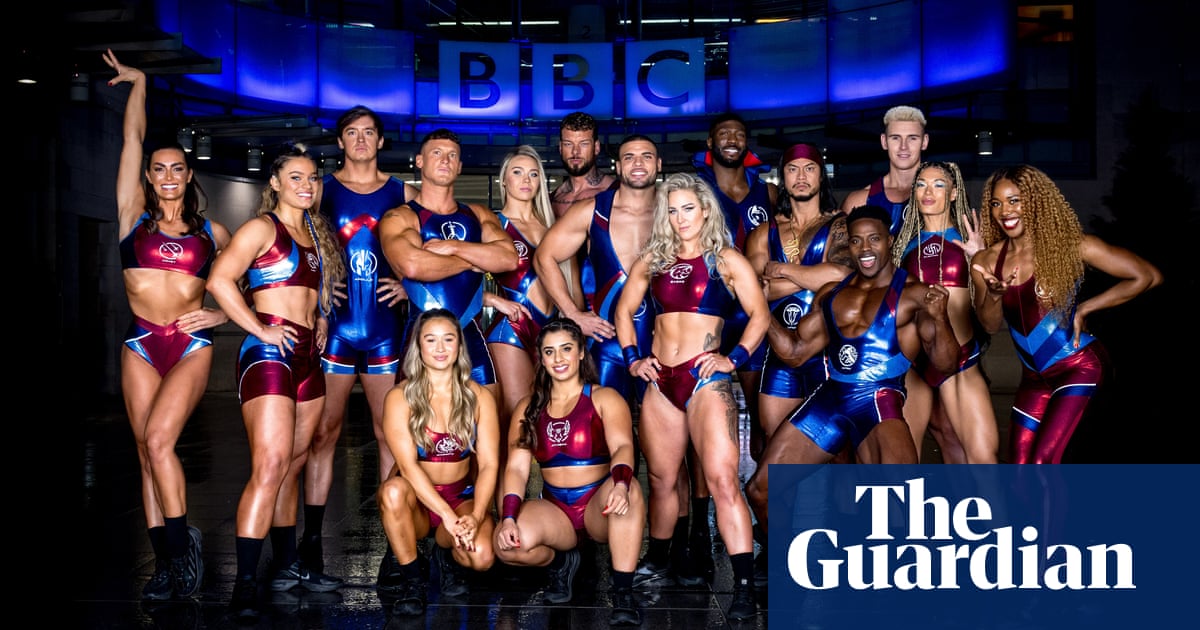
At the Protein Pick and Mix store in Tunbridge Wells, you can have any snack you like, as long as it comes with extra protein. Protein pancakes, protein burger buns, protein muffins, protein nachos, protein croissants. Protein bars, of course, in every conceivable flavour: caramel millionaire’s shortbread, New York cheesecake, mint chocolate chip, double chocolate fudge, lemon drizzle, cinnamon swirl. White chocolate chip cookies that incorporate something called a “high protein lean matrix”.
I am being shown around the store and warehouse by the founder, Anthony Rodgers, 36, who has the well-defined musculature of a man who regularly eats three protein bars a day. He started the business, originally as an online shop, in 2013, after observing the trend for exotically flavoured protein bars in the US. “At the time I was an avid gym-goer,” he says, “and protein bars were just starting to be a little more creative, a little more exciting. People were putting actual effort into the flavours, and it started to transcend the boring, functional: ‘we’re just going to ram some protein in you.’”
Rodgers is a man ahead of his time. In scarcely a decade, protein has ballooned from a niche supplement favoured by bodybuilders to mainstream macronutrient. According to the market research firm Mintel, 6.1% of food and drink product launches in 2020 claimed to be high-protein or contain added protein, up from 3.3% in 2016. The major multinationals are all muscling in: you can buy Mars, Snickers and Bounty bars with added protein at most newsagents. Mondelēz International, which owns Cadbury and Toblerone, acquired the British protein bar brand Grenade earlier this year in a rumoured £200m deal; Kellogg’s acquired RXBar, another protein bar, for $600m in 2017.
The upmarket grocery chain Whole Foods Market has stocked 50 new protein-enriched products in the past year alone, including chickpea tofu and red lentil pasta. “Our 2022 trend report predicts that sunflower seeds will be a hot protein ingredient next year, being included in butters, milk and even ice-cream,” says the UK director of purchasing and operations, Jade Hoai.
The UK is at the centre of the protein craze: according to Mintel, we have the third-highest percentage of products with a high-protein or added-protein claim in the world, after Finland and Australia. During the first lockdown, demand for Protein Pick and Mix’s products tripled: Rodgers and his staff had to work six days a week, just to keep up with orders.
“It’s amazing how much this stuff has become mainstream,” says Rodgers. “When M&S starts doing protein bars, that’s a serious cultural shift … now even my grandmother loves them. She’s buying boxes.”
This multimillion-dollar industry all started, says Rodgers, with one bar: the Quest Cookies and Cream. Incorporating 21g of protein – slightly less than a can of tuna – it was the first protein bar to cross over into the confectionery aisle. I try one: it has the appearance and mouthfeel of a door stop, and tastes like an in-flight dessert. I would eat it if I was very hungry, or drunk.
The technology behind protein bars has evolved to the point where they almost approximate to ordinary chocolate bars. I sample Rodgers’ personal favourite, the Grenade Chocolate Chip Salted Caramel, which contains 20g of protein. “It’s more like a candy bar,” he promises. “It’s genuinely delicious.” The bar is truly tasty, although afterwards I feel as if I have swallowed a remote control, and have no appetite for dinner. “It is very satiating,” Rodgers explains.
Protein contains the amino acids necessary for muscle growth, which is why added-protein products were initially designed for avid gym-goers seeking to pack on muscle. They were stocked by specialist shops, such as Holland & Barrett. These “functional foods”, which included protein powders and shakes, were branded as sports nutrition and primarily targeted at men. The Protein Pick and Mix marketing manager, Milli Levett, 28, used to work for Grenade, a protein-bar manufacturer. At pop-up events, she struggled to persuade women to eat more protein.
Now, 85% of the Protein Pick and Mix’s customers are women. “Everybody’s jumping on the bandwagon,” says Levett. “Lots of the Instagram girlies love it. They’re all MyProtein [a protein supplement brand] ambassadors.” The Protein Pick and Mix Instagram account has 38,300 followers, many young women who post selfies with the new protein bar du jour. “There’s one who buys a single bar every time we list anything new – just to put it on Instagram,” adds Levett.
These women’s protein appetite tracks out of an endlessly evolving diet culture. In the 2000s, carbohydrates were demonised by fans of the Atkins diet; in the 1990s, fashionable (and flatulent) women subsisted on a cabbage soup crash diet for a week at a time. Today’s mania for protein aligns with the vogue for “wellness”, and the ultra-shredded physiques flaunted on television shows such as Love Island and by athleisure-wearing influencers on Instagram. “Protein is diet culture masquerading as something that fuels exercise,” says Eve Simmons of the blog Not Plant Based, and co-author of Eat It Anyway: Fight the Food Fads, Beat Anxiety and Eat in Peace. “In reality, most of us aren’t doing the exercise that is necessary to [require] that much protein.”
The NHS recommends a daily protein intake of 50g, about the same as two small chicken breasts. “A protein deficit is very unusual in a developed country,” says Clare Thornton-Wood, a dietitian and member of the British Dietetic Association. “People think about protein as meat and fish, but there is protein in many different foods, from cereals to vegetables.” The body can only really break down about 20g-30g of protein at a time. “If you eat more than that in one sitting,” Thornton-Wood says, “you are basically wee-ing it out. It’s going down the toilet.” With many protein bars costing upwards of £2.50 apiece, that is an expensive toilet trip. She also warns that excessive protein can be damaging for people with kidney disease as it puts extra pressure on these organs.
Not all protein bars contain animal products, although some use gelatine as a binder or are made from whey protein, a byproduct of cheese making. Soy is another common source of cheap protein. But the origins of western consumers’ love affair with protein can be traced back to lobbying by the meat industry. “There’s a paranoia about protein,” says Jennie Macdiarmid, professor in sustainable nutrition and health at the University of Aberdeen, “and the market is creating and fuelling this demand.”
Our overconsumption of protein is, says Alexandra Rutishauser-Perera of Action Against Hunger, “mostly because of the myth that has been spread about the requirements about animal protein, in particular at conferences financed by the animal-based food industry.” Research published in the journal Climatic Change in 2021 found that US meat and dairy producers have collectively spent $200m on lobbying since 2000. In 2015, the US government declined to include sustainability as a factor in its official dietary guidelines, in a move widely interpreted as a concession to meat and dairy manufacturers. Had sustainability been factored into the guidance, it is likely that Americans would have been encouraged to reduce their meat intake, the meat industry being a huge driver of emissions.
The average American adult eats 100g of protein a day, twice the recommended amount, while in Madagascar, 50% of children have stunted growth due to protein deficiency. “The consequences of protein deficiency can be not developing properly, not being able to do well in school due to reduced cognitive abilities,” says Rutishauser-Perera.
And, of course, the elephant in the exercise studio is the climate emergency. While hulking gym bros strip chicken carcasses daily, and teenagers scoff burgers on the school bus, Madagascar is experiencing its worst drought in four decades, caused directly by climate change. Protein-rich western diets are partly to blame. “Meat contributes significantly to greenhouse gas emissions compared to other foods,” says Macdiarmid, “both in terms of ruminant meats, which produce methane, but also in terms of the amount of land taken up to produce feed for animals.” In 2020, the Climate Change Committee advised the UK public to reduce consumption of meat and dairy by 20% for climate reasons.
If we don’t need to eat all this protein, why are we devouring so much? For many, it’s the pursuit of the body beautiful. The word protein semaphores virtuous self-restraint, visibly striated musculature and pert buttocks. Protein is eating clean and boutique gym memberships. Protein is nut bars nibbled elegantly between MacBook-led meetings. When we reach for protein-rich snacks, what we are really reaching for is a thinner version of ourselves, even if we substitute the word thin for other, more socially acceptable adjectives: lean, defined, fit.
Protein and diet culture go together like supermodels and garden salads, for the simple reason that a protein-rich diet can aid fat loss and build lean muscle (provided you exercise too). “Protein keeps you fuller for longer,” says Thornton-Wood. “That’s why people on diets often try to eat more protein.” When Simmons, of Not Plant Based, had the eating disorder anorexia in her early 20s, she often bought a takeaway boiled egg pot, in lieu of a meal. “It’s a snack,” Simmons says. “It’s not designed to be a lunch.”
To weight-conscious people, the word protein has a halo effect. “People associate protein with being healthy because it’s not carbs, and carbs have been vilified over the years,” says Simmons. It is telling that one of Rodgers’ bestselling bars, the Carb Killa, sounds as if it promises to expel carbohydrates from our bodies, as though they were cancerous cells, rather than macronutrients that fuel our brains, kidneys and hearts. “Protein is such a buzzword and there are so many diets based around high protein and low carbs,” says Levett. “Everyone knows protein … and if you can link the word protein to their favourite sweet treats, all of a sudden it becomes justifiable.”
The irony is that added-protein snacks are often far from healthy. Many bars contain ingredients such as palm oil, which is high in saturated fat, and corn syrup, which has been linked to insulin resistance. The NHS warns against replacing meals with protein snacks. They are highly processed; those white chocolate chip cookies contain 31 ingredients. “People used to be like, the fewer ingredients the better. I don’t want to put all those chemicals in my body,” says Levett. “Now, nobody cares.”
That is not to say that processed foods can’t form part of a balanced diet, in moderation. “It is always better to eat food that isn’t processed,” says Thornton-Wood. “But I’m realistic. I eat processed foods sometimes.” And some of Rodgers’ chocolate-covered protein bars are arguably healthier than a regular chocolate bar, as they are lower in sugar and will fill you up for longer. “You could have a couple of biscuits that are empty calories, that aren’t doing anything for you,” Rodgers points out reasonably. “Or you could have something that’s quite nice, and is hitting your protein [intake].” Plus, many protein bars are vegan – making them an option for people looking to reduce their meat intake for environmental reasons. (Providing they aren’t full of unsustainably produced palm oil.)
As someone who grew up in the fetid, diet-culture swamp of the mid-00s, and had to rewire her brain over two decades not to liken a bread basket to a bowl of heroin, a warehouse full of low-carbohydrate snacks recalls the disturbed messages of my youth. “It’s almost that guilt-free thing,” says Levett, explaining the appeal of a high-protein Snickers. She’s not wrong – I would probably reach for a high-protein version over a regular chocolate bar myself.
But I wonder if we will ever live in a world where women can eat a Snickers bar without feeling like they have run over a small animal. Until that day comes, there’s always a chocolate-covered Carb Killa, for our sins.












